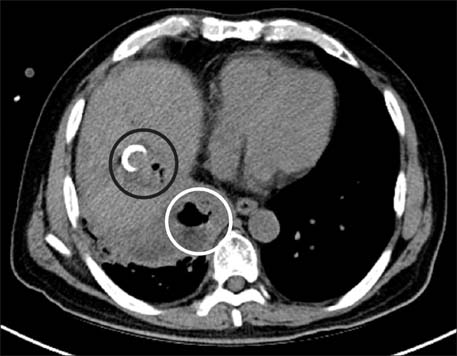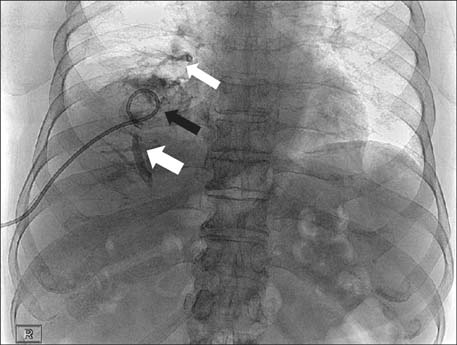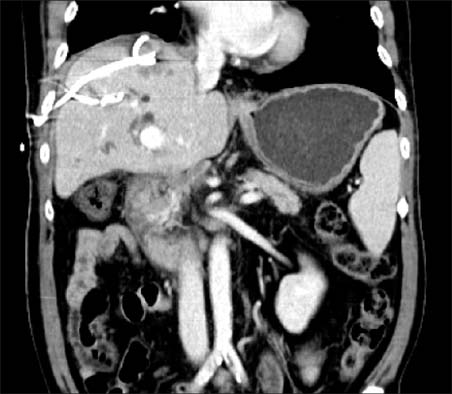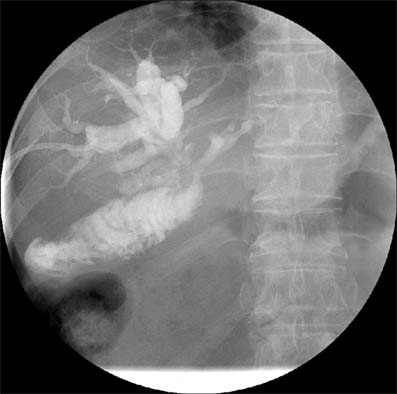Korean J Hepatobiliary Pancreat Surg.
2012 Aug;16(3):110-114. 10.14701/kjhbps.2012.16.3.110.
Successful percutaneous management of bronchobiliary fistula after radiofrequency ablation of metastatic cholangiocarcinoma in a patient who has a postoperative stricture of hepaticojejunostomy site
- Affiliations
-
- 1Department of Surgery, Wonkwang University Hospital, Wonkwang University School of Medicine, Iksan, Korea. Knife@wonkwang.ac.kr
- KMID: 2243216
- DOI: http://doi.org/10.14701/kjhbps.2012.16.3.110
Abstract
- Bronchobiliary fistula (BBF) is a rare condition that is defined as an abnormal communication between the biliary system and bronchial tree. Furthermore, a BBF is an extremely rare complication of radiofrequency ablation (RFA). A 54 year-old man with a history of extrahepatic biliary cancer had been suffering with a benign stricture of hepaticojejunostomy site and was treated with RFA for metastatic cholangicarcinoma. In this report, we describe a patient with BBF complicated by an abscess which occurred after RFA. He was treated by placement of external drainage catheter into the liver abscess and percutaneous transhepatic biliary drainage (PTBD) into the right intrahepatic duct. After 6 weeks, a complete obliteration of the BBF was confirmed by a repeated follow-up of computed tomography scan and cholangiography through PTBD.
MeSH Terms
Figure
Reference
-
1. Peacock TB. Case in which hydatids were expectorated and one of suppuration of hydatid cyst of the liver communicating with the lungs. Edinburgh Med J. 1850. 74:33–46.2. Liao GQ, Wang H, Zhu GY, et al. Management of acquired bronchobiliary fistula: A systematic literature review of 68 cases published in 30 years. World J Gastroenterol. 2011. 17:3842–3849.3. Cropper LD Jr, Gold RE, Roberts LK. Bronchobiliary fistula: management with percutaneous catheter drainage of a subphrenic abscess. J Trauma. 1982. 22:68–70.4. Sutherland RD, Reynolds J, Sugg WL. Bile ptyalism associated with chest trauma and sickle cell crisis simulating bronchobiliary fistula. Ann Thorac Surg. 1972. 13:537–542.5. Moumen M, el Fares F. Bilio-bronchial fistula of hydatid origin. Apropos of 8 cases. J Chir (Paris). 1991. 128:188–192.6. Ong M, Moozar K, Cohen LB. Octreotide in bronchobiliary fistula management. Ann Thorac Surg. 2004. 78:1512–1513.7. Gugenheim J, Ciardullo M, Traynor O, et al. Bronchobiliary fistulas in adults. Ann Surg. 1988. 207:90–94.8. Kim JH, Kim MD, Lee YK, et al. Bronchobiliary fistula treated with histoacryl embolization under bronchoscopic guidance: A case report. Respir Med CME. 2008. 1:164–168.9. Goldman SY, Greben CR, Setton A, et al. Bronchobiliary fistula successfully treated with n-butyl cyanoacrylate via a bronchial approach. J Vasc Interv Radiol. 2007. 18:151–155.
- Full Text Links
- Actions
-
Cited
- CITED
-
- Close
- Share
- Similar articles
-
- Percutaneous Management of a Bronchobiliary Fistula after Radiofrequency Ablation in a Patient with Hepatocellular Carcinoma
- Surgical Treatment of Bronchobiliary Fistula with Pulmonary Resection and Omentopexy
- Surgical treatment of bronchobiliary fistula due to radiofrequency ablation for recurrent hepatocellular carcinoma
- Successful Management of Atrio-Esophageal Fistula after Cardiac Radiofrequency Catheter Ablation
- A Case of Bronchobiliary Fistula as a Complication of Radiofrequency Ablation







